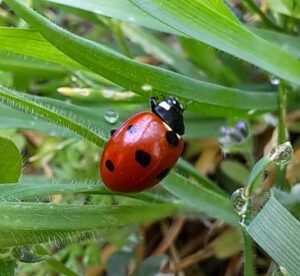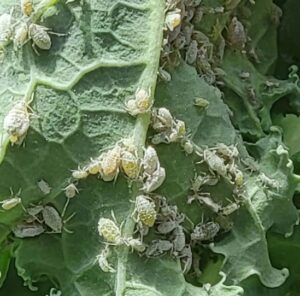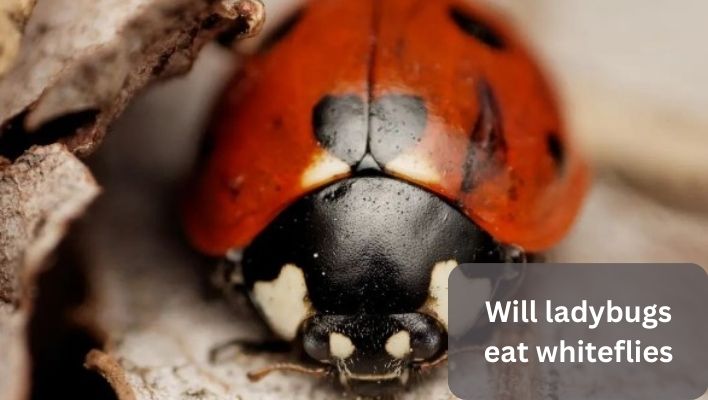Whiteflies are a common pest that can cause serious damage to plants, especially in gardening and agriculture. They feed on plant sap, leading to yellowing, wilting, and stunted growth. While chemical pesticides are often used to control whiteflies, they can negatively affect plant health and the environment.
Fortunately, there is a natural solution – ladybugs. Ladybugs are a type of beneficial insect that can help control whiteflies in a safe and eco-friendly way. Ladybugs offer a natural and effective solution for controlling whiteflies without harmful chemicals. These colorful and harmless insects are voracious predators that feed on whiteflies and other pests.
This article will explore whether ladybugs will eat whiteflies and how they can help control these pests. We’ll also discuss the benefits of using ladybugs over chemical pesticides and the factors affecting their effectiveness. By the end of this article, you’ll better understand how ladybugs can be a valuable tool in managing whitefly infestations.
About whiteflies
Whiteflies are tiny, sap-sucking insects that belong to the Aleyrodidae family. They are found worldwide and are known for their destructive impact on crops and plants. Whiteflies are typically white or yellow in color and have a powdery, waxy appearance. They are usually found on the undersides of leaves and can be difficult to detect due to their small size.
Whiteflies cause damage to plants by feeding on the sap, which can lead to stunted growth, yellowing of leaves, and reduced yields. In addition to the direct damage, whiteflies also secrete a sticky substance called honeydew, which can lead to the growth of sooty mold and attract ants.
Several common whitefly species exist, including the greenhouse whitefly, silverleaf whitefly, and banded-winged whitefly. Each species has slightly different characteristics and preferred host plants. Understanding the type of whitefly you are dealing with can help you choose the most effective control method.
Ladybugs as Natural Predators
Ladybugs, also known as lady beetles or ladybirds, is the most well-known natural enemy of pests. These small, colorful insects are voracious predators that feed on various pests, including aphids, scale insects, and whiteflies.
Over 5,000 species of ladybugs worldwide, with several types eating whiteflies. Some of the most effective whitefly predators include the convergent lady beetle (Hippodamia convergens), the seven-spotted lady beetle (Coccinella septempunctata), and the twice-stabbed lady beetle (Chilocorus stigma). Each species has slightly different preferences regarding habitat and diet, but they all share a common trait of effectively controlling whitefly populations.

Ladybugs hunt and feed on whiteflies in a few different ways. They use their keen sense of smell to locate whiteflies on plants, then use their mandibles to chew through the protective waxy coating and consume the soft interior.
These insects may also lay their eggs on or near whitefly populations, ensuring a steady food supply for their offspring. Ladybugs are an effective and natural control solution for whiteflies and other pests.
Whiteflies vs. Ladybugs: Will ladybugs eat whiteflies?
Ladybugs are known to be effective predators of whiteflies, with research showing that they can significantly reduce whitefly populations in agricultural and garden settings. Ladybugs are attracted to plants that have whiteflies and will actively seek out these pests to feed on.
When feeding on whiteflies, ladybugs use their mandibles to pierce through the protective waxy coating of the insect, allowing them to consume the soft interior. They are known to be voracious feeders and can consume large numbers of whiteflies in a short amount of time.
In fact, studies have demonstrated that ladybugs can reduce whitefly populations by up to 90%. This makes them a highly valuable tool for farmers and gardeners looking for a natural and effective control solution for whiteflies.
Scientific studies have shown that ladybugs can be an effective natural control method for whiteflies. For example, a study conducted by researchers at the University of California found that releasing ladybugs in a greenhouse reduced whitefly populations by over 50% within a week. Another Israel study demonstrated that ladybugs effectively controlled whiteflies on tomato plants.
Overall, ladybugs are a natural and effective solution for controlling whiteflies, and scientific evidence supports their use as a control method.
Benefits of Using Ladybugs to Control Whiteflies
Using ladybugs to control whiteflies has several advantages over using chemical pesticides. Firstly, ladybugs are a natural and safe solution that does not harm other beneficial insects or the environment, which means they are safe for humans, pets, and beneficial insects like bees and butterflies. In contrast, chemical pesticides can negatively impact non-target species and contaminate soil and water.
Secondly, using ladybugs can improve overall plant health. Whiteflies, like other pests, can weaken plants by feeding on their sap and transmitting diseases. By controlling whiteflies, ladybugs can help improve plant vigor and yield, leading to healthier and more productive crops.

Finally, using ladybugs to control whiteflies is a cost-effective and sustainable solution. Ladybugs can be easily purchased online or from garden stores once released. Once they establish themselves, they can continue to control whiteflies and other pests year after year without additional inputs like chemical pesticides.
Using ladybugs as a natural control solution for whiteflies with no doubt has several benefits over chemical pesticides. They are non-toxic, beneficial to the ecosystem, and cost-effective, making them a sustainable and effective solution for controlling whiteflies and other pests.
How to Attract Ladybugs to Your Garden?
Attracting ladybugs to your garden can be an effective way to control whiteflies and other pests. Here are some strategies to attract ladybugs:
- Plant flowering plants: Ladybugs are attracted to flowering plants like marigolds, calendula, and yarrow. These plants attract ladybugs and provide them with a source of nectar, an important food source.
- Avoid pesticides: Pesticides can harm ladybugs and other beneficial insects, so avoiding using them in your garden is best.
- Provide shelter: Ladybugs need a place to rest and lay their eggs. Sheltering them, such as a pile of rocks or a ladybug house, can encourage them to stay in your garden.
- Provide a source of water: Ladybugs need water to survive, so providing a water source in your garden can help attract them. This can be as simple as a shallow dish filled with water.
- Buy ladybugs: If you’re having trouble attracting ladybugs to your garden, you can also purchase them online or at garden centers. When releasing them, make sure to do so in the early evening when the temperature is cooler, and there is less sunlight.
Attracting ladybugs to your garden can be a great way to control whiteflies and other pests naturally. By planting the right plants, avoiding pesticides, and providing shelter, you can create a welcoming environment for ladybugs in your garden.
Factors that Affect Ladybug Predation
While ladybugs are an effective natural control solution for whiteflies, several factors can affect their effectiveness. Here are some of the factors that can influence ladybug predation:
- Environmental conditions: Ladybugs are most active in warm, dry conditions, and their populations can be affected by temperature, humidity, and rainfall. If the weather conditions are not ideal, ladybugs may not be as effective in controlling whiteflies.
- Availability of food: Ladybugs require a source of food to survive and reproduce, and their populations can be affected by the availability of their preferred prey, like whiteflies. If there are not enough whiteflies in the area, ladybugs may not be as effective in controlling their populations.
- Competition from other predators: Ladybugs are not the only predators that feed on whiteflies. Their effectiveness in controlling whiteflies can be influenced by competition from other predators like lacewings and parasitic wasps.
- Pesticide use: As mentioned earlier, ladybugs are sensitive to pesticides, and exposure to chemical pesticides can harm their populations and reduce their effectiveness in controlling whiteflies.
- Habitat availability: Ladybugs require a habitat that provides shelter and protection, and the availability of suitable habitats can influence their populations. Creating a habitat that provides shelter and protection, like ladybug houses, can help support ladybug populations.
By considering these factors, you can help create a favorable environment for ladybugs and support their populations, which can, in turn, help control whitefly populations in your garden or farm.
Will ladybugs eat whiteflies’ FAQs?
Do ladybugs only eat whiteflies?
No, ladybugs are generalist predators and will eat a variety of pests, including aphids, mites, and scale insects, in addition to whiteflies. They are particularly effective at controlling aphid populations.
How many ladybugs are needed to control whiteflies?
The number of ladybugs needed to control whiteflies depends on the size of the infestation and the area that needs to be treated. As a general rule, it is recommended to release about 1,500 ladybugs per acre for effective control.
Can ladybugs harm plants?
Ladybugs are not harmful to plants and are considered beneficial insects. They feed on pests that can harm plants, and their presence in the garden improves plant health.
Can I buy ladybugs to release in my garden?
Yes, you can purchase ladybugs online or at garden centers for release in your garden. It is important to release ladybugs in the early evening when the temperature is cooler, and there is less sunlight.
Can ladybugs be harmful to plants?
No, ladybugs are not harmful to plants. They do not feed on plant tissue and only feed on pests like whiteflies and aphids.
What are the alternatives to ladybugs for controlling whiteflies?
There are several alternatives to ladybugs for controlling whiteflies, including parasitic wasps, predatory mites, and insecticidal soaps. However, these methods may not be as effective as using ladybugs and may also harm beneficial insects like bees and butterflies. It is recommended to use natural control methods like ladybugs before resorting to chemical pesticides.
Conclusion
In summary, ladybugs are effective natural predators of whiteflies and other pests in the garden. Ladybugs can be used as an alternative to chemical pesticides, providing many benefits for plant health and the environment. To attract ladybugs to your garden, you can plant flowers that they are attracted to, create a favorable environment for them, and even use ladybug houses.
Although ladybugs are not the only natural control method available, they are one of the most effective and beneficial options. By using natural control methods like ladybugs, we can maintain healthy and thriving gardens without harming beneficial insects like bees and butterflies.
However, several factors can affect their predation effectiveness, and creating a conducive environment for their survival is essential. Overall, natural control methods like using ladybugs are crucial for sustainable gardening practices and the long-term health of our ecosystem.
